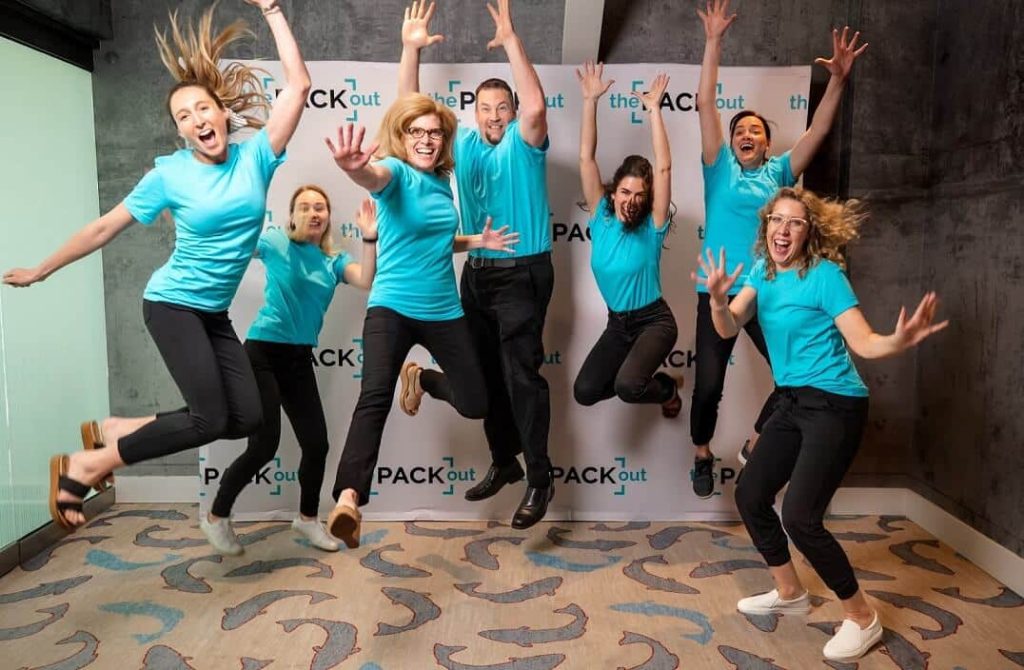

ThePACKout conference for healthcare packaging professionals on May 10-12, in Austin, Texas, was an outstanding event where leaders shared insights, challenged the status quo, and real-life on-stage demonstrations sparked discussion and packaging engineering energy.
As a leader in the industry, PCL has two members on the founding committee. Sarah Rosenblum, Senior Director of Sales and Marketing, and Cassie Ladd, Sales and Marketing Manager, helped spearhead this dynamic event, and recently sat down with PCL’s Matt TerBush, Senior Laboratory Packaging Engineer, to share their favorite sessions and insights. We are including the session abstracts to set the stage for our team’s discussion.
“ThePACKout is a unique packaging conference that the founding members developed from personal and industry needs,” says Cassie. “We looked forward to filling gaps from other offerings and providing a collaborative, innovative, and authentic experience for sterile packaging engineers in all parts of the MedTech industry. It was a lot of work to develop the agenda, get the speakers, and produce this event. In the end, it was just what our industry needs to stay on track and provide great products for customers.”
Sarah’s favorite sessions
While all the sessions were excellent, PCL’s team had their favorites. One of Sarah’s was “From Rodeo Cowboy to Spiderman: Key Insights for Career Success,” with Brian Farison of Network Partners. Brian Farison is Technical Fellow with Network Partners with over 37 years of combined experience in packaging, medical devices, and process excellence. His career expertise spans the areas of structural and medical package design, process development and validation, Six Sigma and Lean process improvement, project management, quality and compliance, risk mitigation, and deployment of strategic high-visibility projects and initiatives.
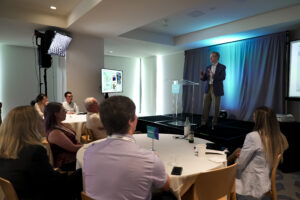
Abstract: Have you ever heard that “Change is the only Constant”? This statement is especially true when discussing professional development. If you want to not just survive but thrive in the face of change, you must be able to adapt, rebound from failure, and even reinvent yourself over the course of your career. Come join Brian Farison for this engaging session where he will share his personal and professional story that spans over 37 years in the Packaging field, covering multiple positions, organizations, and industries. Brian will share key insights that you can immediately apply to ensure a long, successful, and fulfilling career.
“Failure doesn’t necessarily equate to your career being over” was one of his points, and he provided cool insights on how to reinvent yourself, stay present and stay active in the industry, Sarah said. “He was extremely engaging and easy to listen to. I liked how he talked about getting laid off from his job, kind of like how a cowboy gets bucked off a horse and lands on his back. Then the next time he was laid off, he landed on his feet and was ready to go, like Spiderman. It made for a great story.”
“He spoke about discovering what your purpose is and how there are four quadrants that can come together to form a purpose,” added Cassie. “The four quadrants are something you love to do, something you’re good at, something you can make money doing, and the world needs what you do. There are times when the four quadrants separate, and how that is important to keep them intersecting, which ensures that you’re doing work that fuels your soul.”
In today’s market, the topic also relates to failures in the lab, adds Matt. “Maybe the first package design fails, but with repeat testing and continuing to develop new strategies, this can lead to better solutions in our industry. Learning from failures applies to many situations.”
Another of Sarah’s favorite sessions was “Wicked Stability: Predicting the Aging Degradation of Materials,” a panel with Henk Blom, Dan Burgess, Rod Patch, with Seema Momin as Moderator.
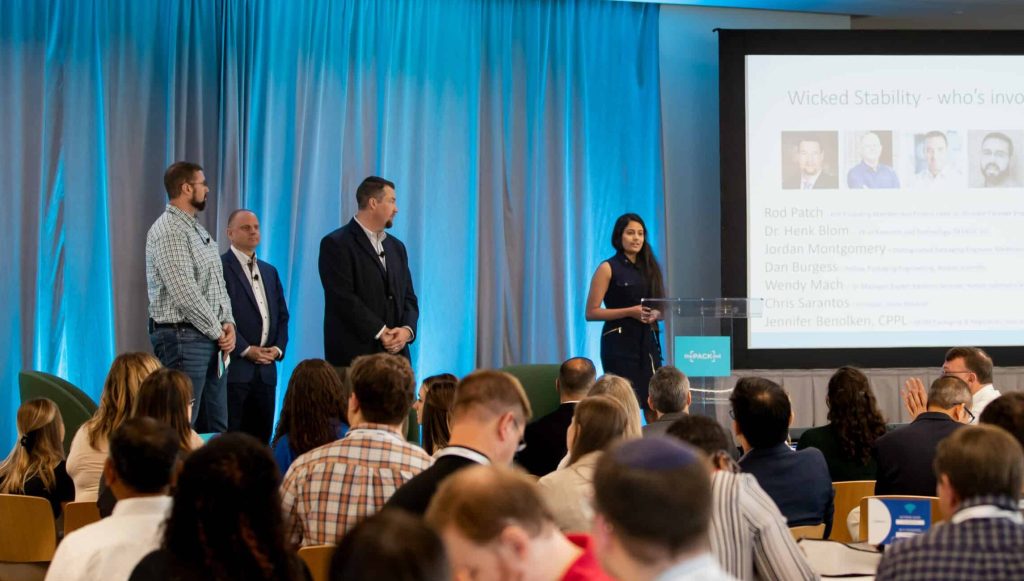
Abstract: The effect of real-time aging, post sterilization, on commonly available sterile barrier packaging systems (SBS) materials, is not significant. Therefore, it is proposed that aging of the typical Materials of Construction (MOC) for SBSs does not need to start from time zero, but rather, knowledge of material science supported by data demonstrates that certain MOC combinations and Modalities of Sterility (MOS) treatments could be placed on the market with a known and supported minimum shelf life.
“Innovation is not accepting how we’ve been doing it for years but taking a look at things from a more pragmatic view,’’ she says. “It was very interesting to see some complex chemistry. We’re looking at ways to approach stability testing differently. It was good to see how materials degrade over time from a chemistry approach, not just an application approach.
“He showed a graph that was showing that we do all these things to degrade material and showed how materials age over time. He came to the chemical conclusion that five years does nothing to material degradation and that you need to do significantly more than that to have an effect. His point was that what we’re doing now is not showing actual degradation. I hate chemistry, but it made it totally understandable and relatable. It was great.”
“A lot of these standards that address the stability of sterile barriers were developed 20 years ago, and the biggest takeaway was seeing how the leaders of industry are thinking outside the box and not accepting the status quo, but are truly looking at different ways to keep patients and end users safe.”
Matt’s favorite sessions
One of Matt’s favorite sessions was “Unpacking Human Factors / Usability Engineering Live Simulation” with Shannon Hoste, Jessie Huisinga and moderated by David DiVaccaro.
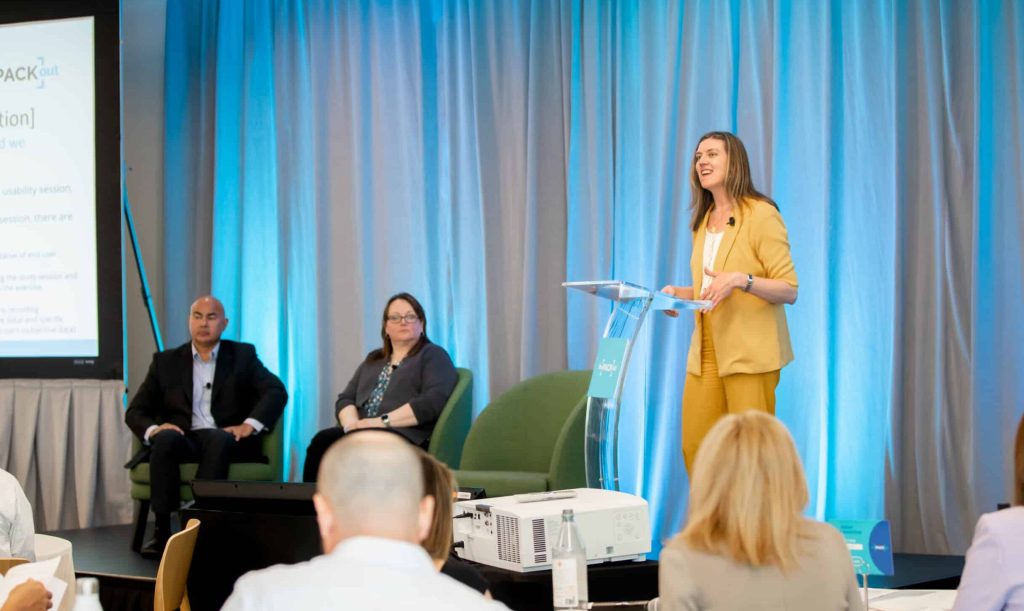
Abstract: Regulations and guidance on human factors continue to evolve as a key area of focus in ensuring products are safe and efficacious for their intended use(s), both domestically and abroad. This focus involves addressing use–related risk–based considerations for packaging and packaging systems. This presentation will provide attendees an introduction to human factors principles, specifically to better understand how packaging and packaging systems are evaluated in human factors/usability studies.
This was a live simulation of a usability evaluation that pertains to ISO 11607.
“It was nice to get confirmation that our program at PCL is right aligned with how the industry is interpreting it. I talked with Jessie, the moderator, and got extra tidbits about how I could conduct these studies in-house. There are a lot of things going on because no one can define usability and aseptic presentation.”
The demonstration included taking a product packaging system from the carton down to the actual product. We saw the user interact with the packaging and saw how that clinical user would have handled it in the real world, he said. “It moved the needle toward developing better standards.”
Another of Matt’s favorites was “Navigating Supply Chain Disruptions Through the Lens of ISO 11607” with Lon Goldbaum. As Sr. Director of Packaging Engineering, Lon brings over 20 years of experience in the medical device field specializing in packaging, labeling, quality, CAPA systems, project management, and sterilization.
Abstract: As packaging engineers in the life sciences industry, we continue to face challenges in a heavily regulated time-sensitive environment. As we secure our supply chains, how do we manage material disruptions while de-risking future ones? When material shortages impact critical components, such as sterile barrier systems, we are tasked with production challenges, while maintaining the safety and efficacy of life-saving products. We have critical decisions to make – do we leverage or completely revalidation under critical time constraints? Which requirements do we fulfill? How can we justify product families? In this session, we will discuss the obstacles and opportunities to address material disruptions through the lens of ISO 11607 and plan for the future. Let’s explore practices that define the balance between maintaining safety and efficacy and keeping lifesaving technology on the market.
With all the supply chain crisis going on now, this one was a lecture about how we as packaging engineers need to weigh risks and describe different types of disruptors that would impact our processing or the way we engineer things, says Matt. “It’s about being proactive, and when things happen, to have a plan in place to mitigate those risks and challenges so we’re still successful.”
Matt also liked the keynote,” “The Impact of Chaotic Innovation on the Medical Packaging Industry,” with Nick Webb. Nick is CEO of LeaderLogic, and is a successful technologist creating award-winning innovations in healthcare, consumer, and industrial technologies. He has bee. n awarded over 40 Patents by the US Patent Office for various landmark technologies. One of Nick’s goals was to create a healthcare documentary, and his film, entitled The Healthcare Cure, was released in 2021 and recently won the Sedona International Film Festival’s, “Audience Choice Award”.
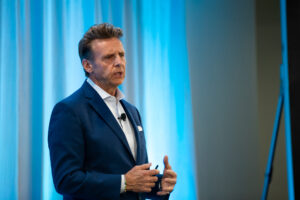
“We’re in a time of chaotic innovation brought on by COVID-19, says Matt. “We need to adapt to the current crisis with our design, usability, and sustainability. If we don’t focus on those things, we’re going to be left in the dark.”
At PCL, we’re dual-sourcing materials, and finding alternative materials so we can bring more packaging solutions to the market. We don’t want to put all our eggs in one basket, he said.
Everyone agrees that thePACKout conference 2022 was a major success, and blended excellent networking opportunities with relevant topics for discussion that will make our services better for clients and the industry. Stay tuned to thepackout.com for next year’s speakers, sessions, and arrangements. See you next year!